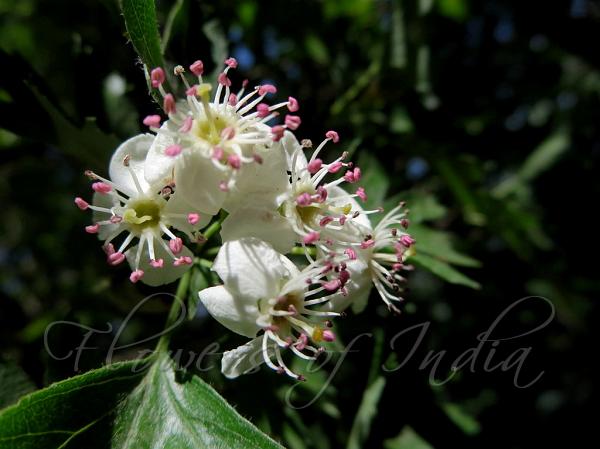|
| Common Hawthorn |
|

|

| File size | 145003 |
| Original date | 4/28/16 9:00 AM |
| Resolution | 1024 x 768 |
| Flash | Flash did not fire, auto |
| Focal length | 4.3mm |
| Exposure time | 1/400s |
| Aperture | 9.0 |
| Focus Distance | |
| Metering Mode | Multi-segment |
| Camera make | Canon |
| Camera model | Canon IXUS 255 HS |
| Sensor type | OneChipColorArea |
|
|
|
|
Photo: |
Botanical name: Crataegus monogyna Family: Rosaceae (Rose family)
Common Hawthorn is a shrub or small tree 5-14 m
tall, with a dense crown. The bark is dull brown with vertical orange
cracks. The younger stems bear sharp thorns, 1 to 1.5 cm long. The
leaves are 2-4 cm long, obovate and deeply lobed, sometimes almost to
the midrib, with the lobes spreading at a wide angle. The upper surface
is dark green above and paler underneath. White flowers are produced in
late spring in corymbs of 5-25 together. Each flower is about 1 cm
across, and has five white petals, numerous red stamens, and a single
style; they are moderately fragrant. They are pollinated by midges and
later in the year bear numerous haws. The haw is a small, oval dark red
fruit about 1 cm long, berry-like, but structurally a pome containing a
single seed. Haws are important for wildlife in winter, particularly
thrushes and waxwings; these birds eat the haws and disperse the seeds
in their droppings. It is distinguished from the related but less
widespread Midland Hawthorn (C. laevigata) by its more upright growth,
the leaves being deeply lobed, with spreading lobes, and in the flowers
having just one style, not two or three. However they are inter-fertile
and hybrids occur frequently; they are only entirely distinct in their
more typical forms.
Medicinal uses:  Common Hawthorn is one of the most common species used as the
"hawthorn" of traditional herbalism, which is of considerable interest
for treating cardiac insufficiency by evidence-based medicine. The
plant parts used medicinally are usually sprigs with both leaves and
flowers, or alternatively the fruit. Several species of Crataegus have
both traditional and modern medicinal uses. It is a good source of
antioxidant phytochemicals,especially extracts of hawthorn leaves with
flowers.
Common Hawthorn is one of the most common species used as the
"hawthorn" of traditional herbalism, which is of considerable interest
for treating cardiac insufficiency by evidence-based medicine. The
plant parts used medicinally are usually sprigs with both leaves and
flowers, or alternatively the fruit. Several species of Crataegus have
both traditional and modern medicinal uses. It is a good source of
antioxidant phytochemicals,especially extracts of hawthorn leaves with
flowers.
 Common Hawthorn is one of the most common species used as the
"hawthorn" of traditional herbalism, which is of considerable interest
for treating cardiac insufficiency by evidence-based medicine. The
plant parts used medicinally are usually sprigs with both leaves and
flowers, or alternatively the fruit. Several species of Crataegus have
both traditional and modern medicinal uses. It is a good source of
antioxidant phytochemicals,especially extracts of hawthorn leaves with
flowers.
Common Hawthorn is one of the most common species used as the
"hawthorn" of traditional herbalism, which is of considerable interest
for treating cardiac insufficiency by evidence-based medicine. The
plant parts used medicinally are usually sprigs with both leaves and
flowers, or alternatively the fruit. Several species of Crataegus have
both traditional and modern medicinal uses. It is a good source of
antioxidant phytochemicals,especially extracts of hawthorn leaves with
flowers. | Identification credit: Prashant Awale | Photographed in Srinagar, Kashmir. |
• Is this flower misidentified? If yes,